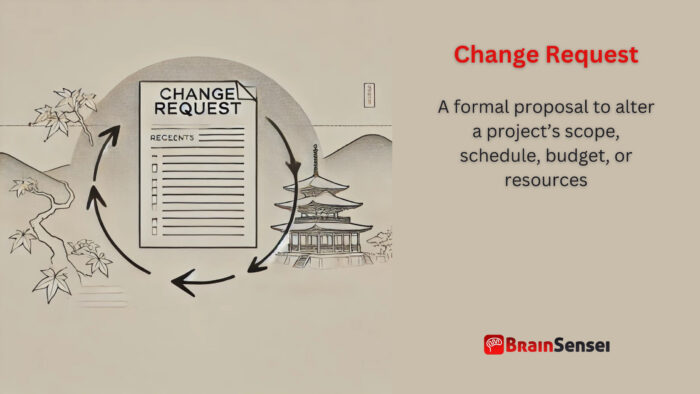
Change Request
What is a Change Request?
A change request in project management is a formal proposal to alter a project’s scope, schedule, budget, or resources. It typically arises when stakeholders identify a need for adjustments due to changing requirements, unforeseen issues, or strategic shifts. Effective change request management meets project goals while accommodating necessary modifications.
Key Takeaways
- Formal process for proposing changes in a project
- Can affect scope, schedule, cost, or resources
- Requires evaluation, approval, and documentation
- Essential for maintaining project control and alignment with objectives
- Helps mitigate risks associated with uncontrolled changes (scope creep)
Understanding Change Requests
How It Works
An initiator submits a change request to adjust a project. The process involves several steps: identifying the need for change, documenting the request, analyzing its impact, and seeking approval from relevant stakeholders. Upon approval of the change request, the project manager updates the project plan and communicates the change to the team.
Key Steps
- Initiation: A stakeholder identifies a necessary change.
- Documentation: The requestor completes a change request form.
- Impact Analysis: Project managers assess the impact on scope, schedule, costs, and risks.
- Approval/Denial: The change control board (CCB) is crucial in reviewing and approving or rejecting the request. Their involvement ensures that decisions are made with the project’s best interests in mind, instilling a sense of security and confidence in the decision-making process.
- Implementation: The project team implements, tracks, and communicates the approved changes.
- Review: The project team evaluates the change’s impact and effectiveness.
Notes
- Poorly managed requests can lead to scope creep.
- Impact analysis is critical for informed decision-making.
- Clear documentation ensures transparency.
- Stakeholder communication is not just vital, it’s integral for acceptance. Keeping all parties informed and involved in the change request process ensures that everyone’s needs and concerns are addressed, fostering a sense of unity and shared responsibility.
- Aligning changes with business objectives is not just a good practice, it’s a necessity. Doing so ensures that the project remains on track and in line with the organization’s strategic direction, providing reassurance about the project’s overall success and impact.
Related Terms
- Scope Creep: Uncontrolled growth in project scope without adjustments to time, cost, and resources.
- Change Control Board (CCB): A group of stakeholders reviewing and approving change requests.
- Project Scope: The detailed description of work required for project completion.
- Baseline: A fixed reference point to measure project performance.
- Risk Management: Identifying, assessing, and mitigating project risks.
- Project Plan: A formal document outlining the project’s execution and control.
Examples of Change Requests Across Industries
Construction Industry (Manufacturing)
A construction project for a new commercial building receives a change request to modify the HVAC system specifications due to updated energy efficiency regulations. The request entails additional costs and schedule adjustments. The project manager conducts an impact analysis, and the CCB approves the request after assessing long-term cost savings. This change highlights how regulatory requirements can influence project specifications and the need for flexibility in project plans. Additionally, the team has to coordinate with suppliers and contractors to ensure the new HVAC systems are compatible with existing structures, which adds complexity but ensures compliance and sustainability.
Moreover, the construction team must adjust procurement plans and communicate the changes across departments. They organized training sessions to familiarize the workers with the new equipment and installation procedures. While initially disruptive, this request results in a more energy-efficient and compliant building that meets modern standards.
Healthcare Industry (Healthcare & Pharmaceuticals)
A hospital IT project implementing a new patient records system submits a change request to add a feature for telehealth integration due to increased demand for remote consultations. The IT team analyzes the impact on development timelines and approves the request, ensuring the system supports new healthcare delivery models. This change requires collaboration with healthcare professionals to identify critical functionalities for telehealth services, such as secure video conferencing, data encryption, and real-time patient monitoring.
The development team conducted multiple testing phases to address potential cybersecurity vulnerabilities. They introduced new workflows, necessitating training programs for medical staff to adapt to the updated system. The project experienced slight delays but ultimately delivered a system that aligns with emerging healthcare trends, providing better patient accessibility and service efficiency.
Government Sector (Government & Public Services)
A government agency’s infrastructure upgrade project receives a request to change suppliers due to a newly introduced sustainability policy. The project manager evaluates the implications for the budget and timeline, and the CCB approves the request after confirming compliance with environmental regulations. The supplier change requires renegotiating contracts, updating procurement processes, and recalibrating project schedules.
The agency organizes community forums to inform the public that it is environmentally friendly. The project team collaborates with legal advisors to meet contractual obligations without incurring penalties. This change reflects how public-sector projects must adapt to policy shifts while maintaining transparency and public trust.
Additionally, the project team implements monitoring systems to track material quality and supplier performance. This proactive approach ensures that the project meets sustainability without compromising infrastructure integrity. The experience underscores the importance of agility in government projects when facing regulatory or policy changes.
When properly managed, these examples demonstrate that change requests enable projects to adapt to external demands, improve performance, and maintain compliance across various industries. From IT and software development to construction and telecommunications, change requests are a versatile tool for managing project adjustments and ensuring project success.
Use Cases of Change Requests
United States (IT & Software)
A software development company in California receives a client request to add a new feature to an ongoing mobile application project. The project manager documents the request, performs an impact analysis, and secures approval from the CCB. The added feature enhances user engagement, leading to increased customer satisfaction. The process includes multiple stages of internal review, client feedback, and incremental testing to ensure the new feature aligns with user expectations and technical standards.
The team also addresses potential risks, such as increased server load and potential integration challenges with existing code. After implementing the change, the company monitors user engagement metrics to measure the feature’s impact, discovering a 25% increase in user retention.
Germany (Construction)
A German construction company working on a shopping mall project submits a change request to use environmentally friendly materials following new EU regulations. The project team evaluates costs and schedule impacts, gains approval, and successfully implements the change, ensuring regulatory compliance and corporate sustainability goals. The shift requires renegotiating contracts with suppliers and reassessing the construction schedule to accommodate the new materials.
The change also demands additional worker training and updating architectural plans to reflect material differences. Despite initial setbacks, the project concludes successfully, with the mall receiving certifications for energy efficiency and environmental stewardship. Post-project reviews highlight the value of aligning with regulatory trends and customer expectations.
India (Telecommunications)
A telecommunications firm in India requested that a major client upgrade its network infrastructure for a faster 5G rollout. The project team followed the change request process, secured approval, and completed the upgrade, enhancing the client’s network capabilities. The process involved feasibility studies, vendor selection, and coordination with government bodies for necessary permits.
Technical teams perform extensive testing to ensure compatibility with existing infrastructure, while marketing teams collaborate to inform customers about improved services. The project’s success demonstrates the importance of cross-departmental cooperation in handling major technological upgrades. As a result, the firm secures additional contracts based on its proven efficiency.
These cases illustrate how the systematic handling of change requests supports project objectives while mitigating potential disruptions.
Best Practices for Managing Change Requests
Effective change request management requires more than a checklist; it involves a strategic approach aligned with the project’s objectives. Below are expanded best practices to ensure the process is thorough, efficient, and beneficial to project success.
Establish a Formal Process
Having a well-defined process is essential. This process should clearly outline the steps for submitting, reviewing, and implementing change requests. It ensures consistency and accountability throughout the project lifecycle. Project managers can develop standardized templates for documentation and communication, reducing ambiguity and improving clarity.
Conduct Comprehensive Impact Analyses
Impact analysis is critical to understanding the potential repercussions of a change. This analysis evaluates how the change affects the project’s scope, timeline, cost, and resources. Risk assessments should also be part of this analysis to identify potential pitfalls. For example, introducing a new software feature may extend development time, impact performance, or require additional testing resources.
Maintain Transparent Communication
Communicating the change request process and its implications to all stakeholders is vital. Regular updates and status reports can help maintain stakeholder engagement and support. Communication tools like project management software can facilitate real-time updates and document sharing.
Document Every Change
Proper documentation creates a historical record of changes, including the rationale behind each request, the approval process, and the implementation steps. This documentation is invaluable for future reference, audits, and lessons learned. It also provides transparency, ensuring all team members understand the reasons behind project adjustments.
Empower the Change Control Board (CCB)
The CCB plays a pivotal role in evaluating and approving change requests. Ensuring this board includes individuals with the appropriate expertise and decision-making authority can streamline the approval process. The CCB should meet regularly to review pending requests and adapt policies based on project dynamics.
Train Project Teams
Regular training sessions can help team members understand the importance of the change request process and their roles within it. Training should cover documentation practices, tools, and techniques for conducting impact analyses. Case studies of past projects can illustrate the consequences of poor change management and reinforce best practices.
Monitor and Evaluate Change Implementation
Implementing a change is not the end of the process; continuous monitoring is necessary to ensure the change delivers the expected benefits. Key performance indicators (KPIs) can help track the impact, while post-implementation reviews can provide insights into what went well and what could be improved.
By following these best practices, project managers can maintain control over project changes, minimize disruptions, and align outcomes with stakeholder expectations.
Common Mistakes and Issues
Effectively managing change requests is critical to a project’s success. However, several common mistakes and issues can hinder the process, causing delays, cost overruns, and compromised project outcomes. Below is an in-depth look at these pitfalls and how they can impact project management.
Inadequate Documentation
One of the most prevalent mistakes in change request management is the lack of proper documentation. When the project does not sufficiently document the change, it leads to confusion, misunderstandings, and misaligned expectations among stakeholders. Documentation should include the rationale for the change, the anticipated impact, and the steps for implementation. A well-maintained log of change requests serves as a historical reference and aids in future decision-making.
For instance, in a large-scale IT infrastructure project, a failure to document several minor changes resulted in incompatible system components. The project team had to invest additional time and resources to resolve the discrepancies, ultimately delaying the project’s completion.
Lack of Impact Analysis
Another significant issue is skipping or conducting a superficial impact analysis. The Change Control Board (CCB) should analyze each change request thoroughly to assess its potential effects on the project’s scope, schedule, cost, resources, and risks. Neglecting this step can lead to unforeseen complications, such as resource shortages or missed deadlines.
A healthcare software development project provides a cautionary tale: the CCB approved a request to add new functionality for telehealth services without a comprehensive impact analysis. As a result, the software’s performance degraded under increased load, requiring costly patches and rework.
Delayed Approvals
Timely decision-making is crucial in change request management. Delays in the approval process can stall project progress and disrupt team workflows. These delays often stem from unclear approval protocols, inefficient communication channels, or unavailability of decision-makers.
In a construction project for a commercial complex, a request to modify the building’s facade design languished in the approval pipeline for months. The resulting delay caused missed deadlines and contractual penalties. Streamlining approval workflows and clearly defining decision-making responsibilities can prevent such setbacks.
Ignoring Stakeholder Input
Change requests impact various stakeholders, from project teams to end-users. Ignoring their input can lead to resistance, dissatisfaction, and project outcomes that do not align with user needs. Engaging stakeholders throughout the process fosters buy-in and ensures that changes meet their requirements.
A municipal infrastructure upgrade project illustrates this point. The project team approved a change request to switch materials without consulting the maintenance staff. The new materials required specialized equipment for upkeep, increasing operational costs post-implementation.
Scope Creep
Scope creep occurs when someone introduces changes without proper evaluation or approval, gradually expanding the project’s scope beyond its original objectives. This issue often results from weak change control processes, where requests are informally communicated and implemented without assessing their impact.
For example, a marketing firm’s website redesign project suffered from persistent scope creep. Multiple unapproved additions to the site’s features inflated costs and extended the timeline by several months. Establishing stringent protocols for submitting and approving change requests can mitigate this risk.
Resource Misallocation
Change requests can necessitate resource reallocation, but misjudging the required resources can disrupt ongoing activities. Project managers must assess resource availability and capacity when evaluating change requests to avoid overstretching the team.
A logistics company’s attempt to integrate new tracking software into its operations demonstrates this issue. The project team underestimated the resources needed for the integration, pulling staff from critical tasks and affecting day-to-day operations.
Insufficient Training and Communication
Implementing changes without adequately training personnel or communicating the adjustments to all relevant parties can lead to confusion and decreased productivity. Project managers should develop training programs and communication plans to support change implementation.
In a retail chain’s point-of-sale system upgrade, employees received minimal training on the new software. The resulting operational errors led to delayed transactions and frustrated customers, negatively impacting the company’s reputation.
Avoiding these common mistakes requires a proactive approach to change request management. By documenting requests thoroughly, conducting detailed impact analyses, engaging stakeholders, and enforcing strict change control processes, project managers can navigate the complexities of project adjustments successfully. Learning from past errors and continuously refining change request protocols will ultimately enhance project outcomes and organizational performance.
Frequently Asked Questions (FAQs)
What is the purpose of a change request
A change request formalizes proposed project adjustments to ensure they are evaluated, documented, and implemented with stakeholder approval, maintaining project integrity.
Who approves change requests in a project?
The change control board (CCB) typically reviews, approves, or rejects change requests based on impact assessments and project objectives.
What are the most common reasons for change requests?
Common reasons include evolving client requirements, regulatory changes, unforeseen risks, and technological advancements.
How can change requests impact a project?
Change requests can affect timelines, budgets, resources, and overall project scope, requiring careful management to minimize disruptions.
What is the difference between a change request and scope creep?
A change request follows a structured process with approvals, whereas scope creep involves uncontrolled and unapproved scope changes.
Additional Resources
- Change Management Plan And Change Control System: How, What and Why
- The Essential 7 R’s for Success: Change Request
Preparing for a PMI certification?
- Exam Prep Courses: PMP®, CAPM®, and PMI-ACP®
- Exam Simulators: PMP®, CAPM®, PMI-ACP®, PMI-PBA®, PMI-RMP®, PMI-SP®, PgMP®, and PfMP®
- Professional Development Units (PDUs): 15, 30, and 60 PDU Bundles



